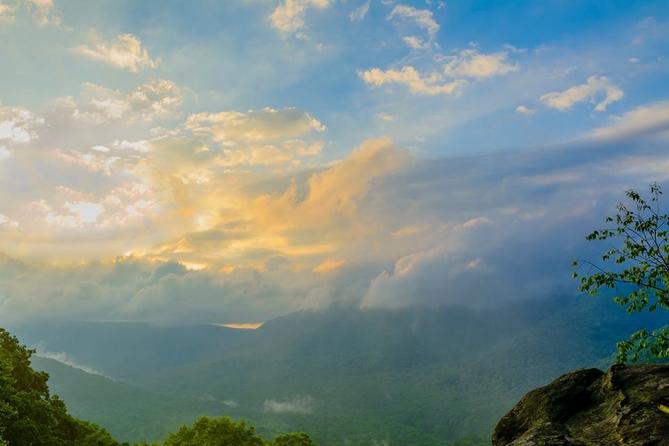This story first appeared in PA Local, a weekly newsletter by Spotlight PA taking a fresh, positive look at the incredible people, beautiful places, and delicious food of Pennsylvania. Sign up for free here.
Tucked deep in Pennsylvania’s verdant southwest pocket, at the elbow of a river flowing south to north, is one of the commonwealth’s wettest places.
Fayette County’s Ohiopyle State Park, named for its waterfalls, sees an exceptional amount of precipitation each year. It is lush. It is biodiverse. But is it a rainforest?
Appalachia claims several temperate (not tropical) rainforests, and at least one website lists Ohiopyle State Park as a northernmost example.
The park appears to meet several criteria established in 1991 by forest ecologist Paul Alaback, the internet’s preferred temperate rainforest standard-setter.
It has infrequent fires, relatively mild temperatures, and a dormant plant season coinciding with winter.
But it falls short — just short — of a critical metric.
“Alaback's definition is annual rainfall greater than 1,400 mm,” Ben Lee, a former postdoctoral research fellow in biology at the Carnegie Museum of Natural History in Pittsburgh, explained by email. “While not an authoritative source, this reference lists Ohiopyle's annual rainfall at 54.21 inches, or ~1,370 mm per year, so just under the threshold. … As far as I am aware, there is nowhere in Pennsylvania that would be considered a temperate rainforest.”
Data from the park’s nearest National Weather Service weather station don’t reach the minimum either.
The closest area meeting Alaback’s conditions, then, would be Monongahela National Forest in West Virginia — an hour and fifteen minutes due south. And there are bigger qualifiers further down in Tennessee’s Smoky Mountains and North Carolina.
But this is where things get fluid. As a result, whether Appalachia’s rainy forests actually qualify as rainforests depends largely on who you ask.
“Outside of the Pacific Northwest, temperate rainforests have, and continue to be, loosely defined and overlaid on eastern deciduous forests,” Eric Burkhart, program director of Appalachian botany at Shaver’s Creek Environmental Center in Huntingdon County, explained.
Burkhart, who’s also a teaching professor at Penn State’s College of Agricultural Sciences, added: “There is a Wikipedia page that seems to lay out an authoritative statement as if this is accepted fact, but note that the information page is disputed and the references are selective and don’t include many of the authoritative references for North American vegetation classification. The most scientific and up-to-date treatment of North American forest types is this [U.S. Forest Service atlas], and note that there are no designated temperate rainforests outside of the Pacific Northwest, unless you see a footnote somewhere I have missed.”
The U.S. Forest Service, in an email to PA Local, confirmed: “The classification for forest types varies by organization, with that being said, the short answer is no, the Forest Service does not classify forest types as temperate rain forests in Appalachia.”
It’s worth noting, as Ben Lee pointed out, that a slightly broader definition than Alaback’s original followed the publication of the 2011 book Temperate and Boreal Rainforests of the World, which Alaback himself contributed to.
Ohiopyle still doesn’t qualify, but it’s undoubtedly special and ecologically significant regardless.
“We’re on the leeward side of the mountain picking up all the moisture as it’s coming across the plains, and this is the first resistance it hits — this part of Chestnut Ridge gets a lot of precipitation,” Amos Ludwig, an environmental education specialist at the park, said by phone.
“The Youghiogheny River Gorge provides a kind of microclimate, and as far as the state of Pennsylvania goes, there are a lot of species that are only found here in the park. These species come up from the south and this is their only foothold in the whole state,” he added. The endangered Barbara’s buttons, for one, thrives there.
Of course, climate change is already altering forests, ecosystems, and weather patterns, meaning one day rainforest rosters could be upended too.
As someone who grew up in the 1990s, an era of Captain Planet and “Save the Amazon” benefit concerts, this part feels familiar. And for all of that cultural moment’s commercial trappings, Vox reports the 90s saw concrete conservation progress in places like Costa Rica — home to “the lungs of the world.”
Thirty years later and anxiety is rising elsewhere.
Barbara Wallace, another environmental education specialist at Ohiopyle, told PA Local that anecdotally they’re seeing more flooding events, less snowfall, “crazy amounts of storms,” and, last year, a rare tornado.
With climate change in mind, Wallace said the park is doing “large-scale resource management” with its forests and favoring types of trees, like oaks, that are more resistant to fire and other extremes.
Ephraim Zimmerman, science director for the Pennsylvania Natural Heritage Program at the Western Pennsylvania Conservancy, said Ohiopyle’s weather will continue to intensify and change, meaning maybe the thing it has most in common with the rainforests I fixated on in my youth is an existential threat and a chance to do something about it.
BEFORE YOU GO… If you learned something from this article, pay it forward and contribute to Spotlight PA at spotlightpa.org/donate. Spotlight PA is funded by foundations and readers like you who are committed to accountability journalism that gets results.

